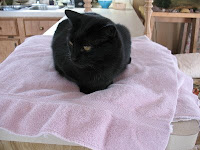
Just in time, my Poultry Catalogue appeared. It followed hot on the heels of my seed catalogue, and like warm weather, is a welcome reminder that we are not doomed to eternal winter.
I've watched this catalogue change over the years. When I first received it, they offered a wide assortment of poultry, including ducks and geese. A few years ago they sent an edition that had all the ducks and geese and some of the fancier varieties of chickens and pheasants removed, due, they said, to the concern of avian flu.
I wonder how many other pandemics we will have to consider in our lives and how they will affect us. For the first few months after the "discovery" of avian flu (which I've heard is actually the previously named "Spanish flu" that swept through the early 1900's) we on farms were bombarded with information about keeping poultry "contamination free". Everything from not allowing guests on your farm that have worn footwear on other farms, to how to "suit up" in biohazard gear before entering your poultry establishment. The threat of avian-borne disaster seems to have diminished in the last few years in as much as the pamphleteering has stopped. If it is such a threat, though, I wonder why a vaccine hasn't been developed against it? We already vaccinate our chicks against Marek's disease, why not the spanish flu? Surely it would make more sense to inoculate chicks at the start than killing flocks of 60,000 mature birds.
Nevertheless, all this is just my way of saying that because of an alleged threat, one side effect has been the diminution of choice for the poultry grower.

I raise chickens for their eggs only. I do not buy and raise birds for meat. I have found that my favorite breed is the sex-sal-link (a hybrid layer, of Red Sussex and another hybrid, also known as ISA). They are nice little red hens that lay giant brown eggs. Two years ago I tried the Red Rock cross, which are black hens with lovely brown collars, and I liked those too. But this year I'm thinking I might try the Ameraucanas for their blue and green eggs, or perhaps some Buff Orpingtons or Brahmas. These are all "heritage breeds" and are more expensive to buy because of their relative rarity. So instead of about $1.50 per chick (for the ISA), these will cost about $5.00 per chick.
I keep a small flock, no more than 75 birds, and usually only about 40. But unlike a lot of farmers I keep them over the winter as long as they live, which can be up to six years. I don't kill them in the fall (like many farmers do) to save the cost of heating, instead I keep them in an insulated coop, complete with heat lamp and booster heater. I do this just to have fresh eggs all year. But the taste, and the healthiness of the eggs is worth it to me. I know they're fed only vegetables and grains (some chicken growers feed leftover beef parings from slaughterhouses to chickens, and some feed them dog or cat food, which often contain chicken or poultry by-products, far from a natural diet). Also, did you know that supermarket eggs can be up to one year old? They are preserved with nitrogen, which allows them to be stockpiled according to market demand. You can test the freshness of an egg by putting it in a glass of water -- if it floats it is not fresh, since the fresher the egg the less of an air pocket there is inside. As an egg sits, it absorbs air through tiny pores in the shell -- therefore the more stale the egg, the larger the air pocket, and the easier it will float in water.
That's probably enough about poultry for one post.
Here's the Magallanes sweater in her near-finished state. I have yet to block the collar and weave in the ends. I don't know what I think of her, she has a nice scoop neck,but the ribbed collar wasn't exactly what I had in mind. I was thinking something more cowly, but I knit to the last drop and had no more yarn. So she's left looking like one of Dracula's brides (from the Coppola version), which might be a bit dramatic. Oh well, we'll give her a try and see what kind of comments I get.

.jpg)











